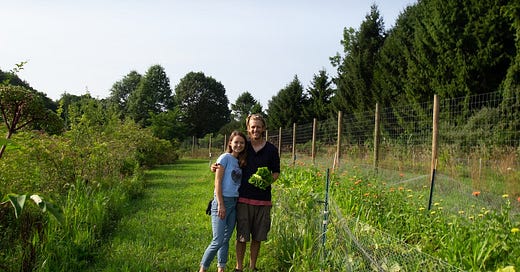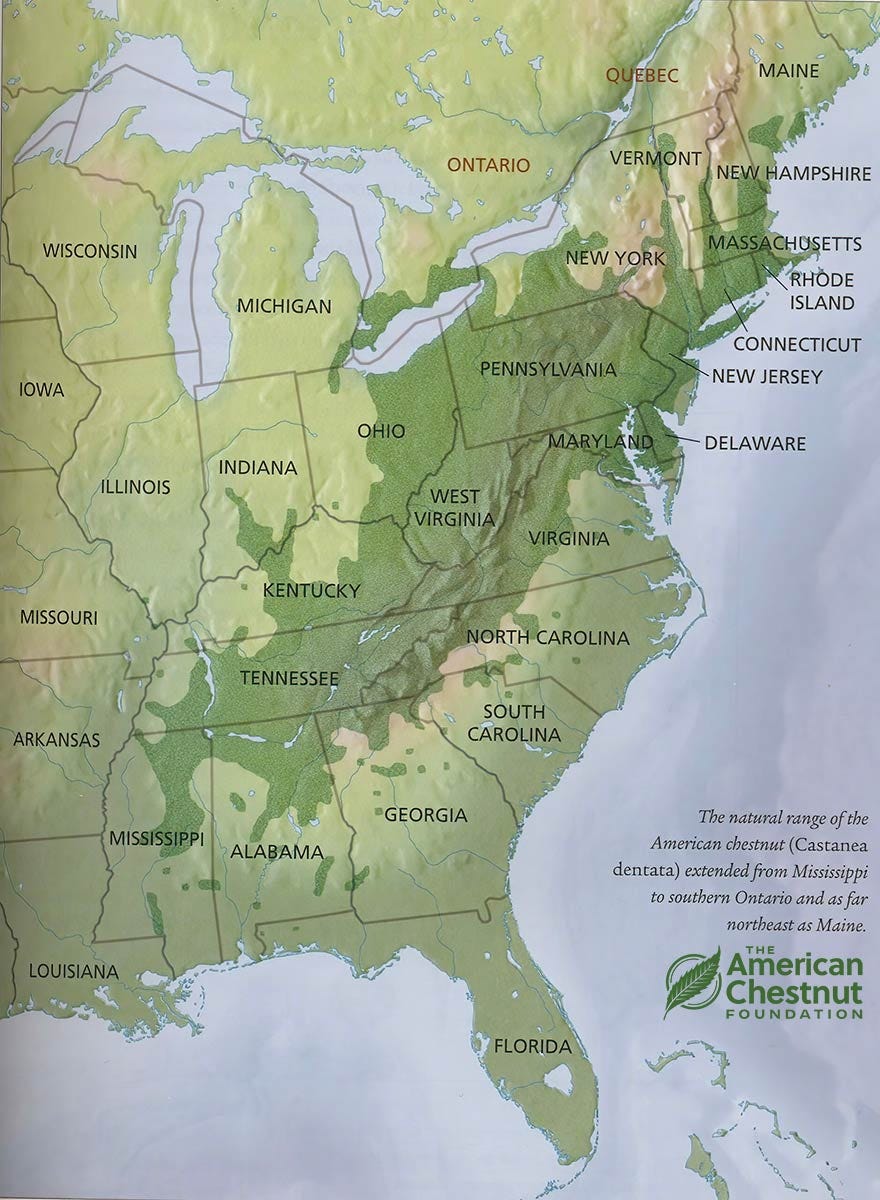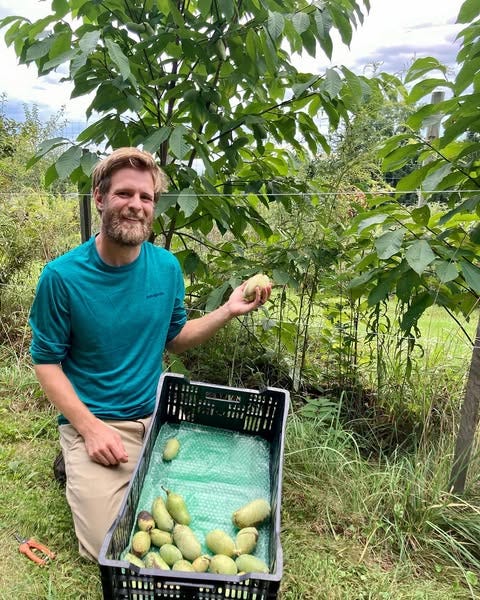American chestnut trees are considered extinct. Meet the farmers trying to bring back chestnuts—hybrids—and revolutionize America's food system.
In Other News #22 // Celebrating the stories of everyday heroes among us.
The word “chestnut” likely triggers an immediate connection in your mind—to thoughts of the holidays, or perhaps to the plight of American chestnut trees, which have disappeared from our forests due to blight. For many, the word “chestnut” evokes nostalgia.
But for one Pennsylvania couple, chestnuts are very much alive—the focus of their livelihood and lives.
Anna and Ethan Strickler are chestnut growers, and they describe this niche corner of agriculture as a fledging industry that ties its multicultural history into untapped future innovations.
Anna and Ethan Strickler; photo credit: Swallowtail Forest Farm
Historic Roots
What kind of reaction do the Stricklers get, when they tell people they grow chestnuts?
“The thing we always joke about is that most people only think of chestnuts as from the song, “Chestnuts Roasting on an Open Fire,” and the little stand on the side of the street in New York City and the sentimentality of chestnuts,” says Anna, “when really, the history of the chestnut in cuisine in the Americas goes back, and is fascinating, and used to be incorporated in so many meals and traditions.”
Not to mention the value of rot-resistant chestnut lumber, used in early American homes and furniture. In some areas of the Mid-Atlantic Region, chestnut trees comprised half of the forests. The trees’ nuts fed many woodland creatures.
But a blight, or fungus, introduced from Asia in the early 1900s, took hold. By the 1950s, nearly all chestnut trees in the United States were gone.
“Ethan’s family grew up in Franklin County and has been there since the early 1800s,” Anna says, “and it’s fascinating to hear his grandfather—who grew up working on the mountain—talk about the history and culture around the American chestnut, and the way the mountains looked. People’s homes and barns were built with it. It’s wild to think about how different the forests look just because of one tree that’s gone.”
All of Pennsylvania’s forests once contained American chestnuts. Image credit: The American Chestnut Foundation.
Chestnuts, with a Hybrid Twist
Today, when the Stricklers talk about their chestnut orchards, they’re talking about hybrid varieties.
“We grow hybrids that are mostly Chinese and Japanese, with thousands of years of breeding work because those parts of the world are centers for chestnut production,” says Ethan.
The Stricklers planted their first chestnut trees nearly 10 years ago, on their 15-acre Swallowtail Forest Farm. It’s a very rural piece of land that’s been in their family for generations, near Mercersburg and Chambersburg, Pa., almost exactly in the center of the state’s southern-most strip of Mason Dixon-bordering counties.
They didn’t exactly set out to be chestnut growers.
Nutrients in the soil had been depleted from years of corn crops, so the Stricklers looked at the family plot with a new vision. They planted a variety of new crops, including garlic, as experiments, to see what would flourish. They incorporated a number of tree crops—chestnuts, persimmons and paw paws— to rejuvenate the land—a practice called agroforestry.
Ethan Strickler, harvesting paw paws. Photo courtesy Swallowtail Forest Farm.
Ten years ago, the term “agroforestry” was relatively unknown. The concept—incorporating trees into agriculture—has been around for centuries. But over the past 10 years, it’s taken root with farmers in a big new way. Many farmers have tapped into the practice because it’s helping their farms become more sustainable against climate change. The practice also helps revitalize soil health, as the Stricklers discovered.
By 2024, their 500 chestnut trees produced 400 pounds of chestnuts. They’re on track to harvest upwards of 1,000 pounds by 2026.
While they’ve discovered some current markets for their unique crop—such as farmers markets in the Washington, D.C. area, where French, Italian, Slavic, Chinese, Korean and Japanese customers are all thankful for “a taste of home”—there are other innovative and largely untapped chestnut markets on the horizon.
“It’s a healthy product—a product with less of a negative environmental footprint. But what we really need, in order for this to be successful is more chestnut growers, so that we can develop an economy around a crop,” says Ethan. “There’s a company trying to connect the bigger food system to chestnuts—that’s the next step.”
There’s a lot to love about chestnuts, nutritionally. Unlike pecans and walnuts, chestnuts contain just a trace of fat. They are the only nut that contains a significant amount of vitamin C. Chestnuts are nutritionally-dense, also containing protein, potassium, high fiber and folic acid.
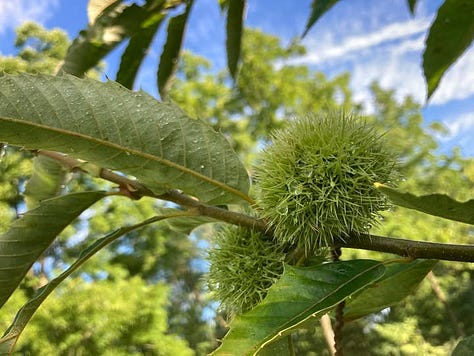
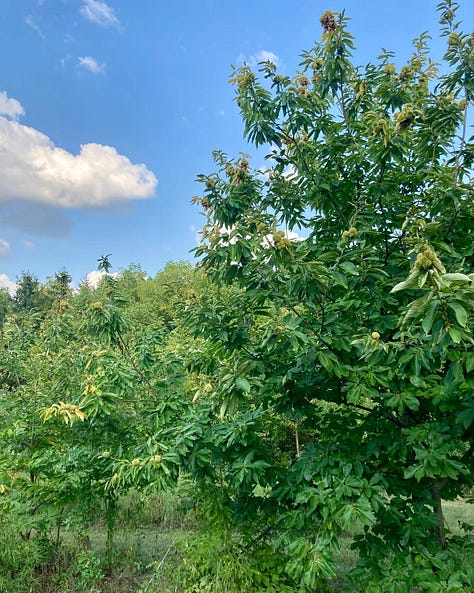
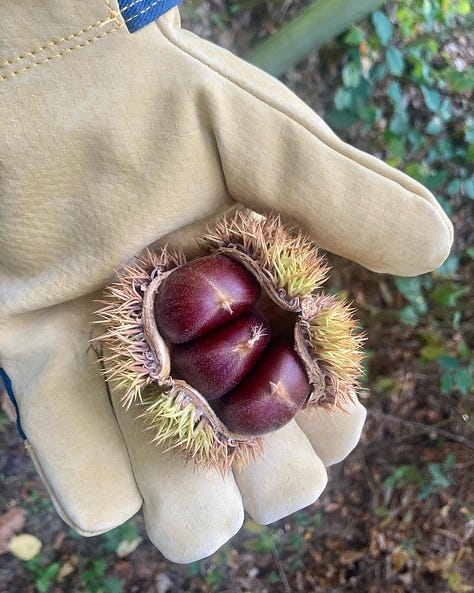
Chestnuts can be ground into a “flour,” similar to what’s called almond flour. It’s thought that the ground-up chestnuts could be incorporated into cereals and granola bars, says Anna. But more chestnut growers are needed, in order to produce the quantity of chestnuts needed to catch the attention of cereal companies and food manufacturers. The Stricklers see the benefits of chestnut farmers uniting to form a co-op in the future.
That’s why Ethan Strickler recently spoke at Pasa Sustainable Agriculture’s annual conference attended by hundreds of Mid-Atlantic farmers in Lancaster, Pa. At a time when many farmers are struggling to raise crops in the face of challenges presented by climate change, Ethan piqued their interest by explaining how resilient chestnut crops are.
“There’s no threat of frost—ever—with chestnuts, unlike fruit crops, because they begin growing around Father’s Day. And the lack of irrigation and rainfall doesn’t affect them,” Ethan says.
With the chestnuts of today, the Stricklers truly believe they’ve discovered an untapped market with limitless potential—as sky-high as the native American chestnuts of yesterday.
“We are learning this as we go; there is no template. We are learning the path as we walk it,” Ethan says. “We are early adopters, so what we’re doing now is figuring out how we share this to help other farmers, so we can get to the next steps, together.”
Are there other untapped crops and markets waiting to be discovered, that American farmers could be growing, especially ones like chestnuts that seem resilient to climate change?
“Yes,” says Ethan, “and that’s an American food system question because the American palette can change over time.”
Nature Nugget
A quick travel tip and photo, sharing incredible views, trails, or parks
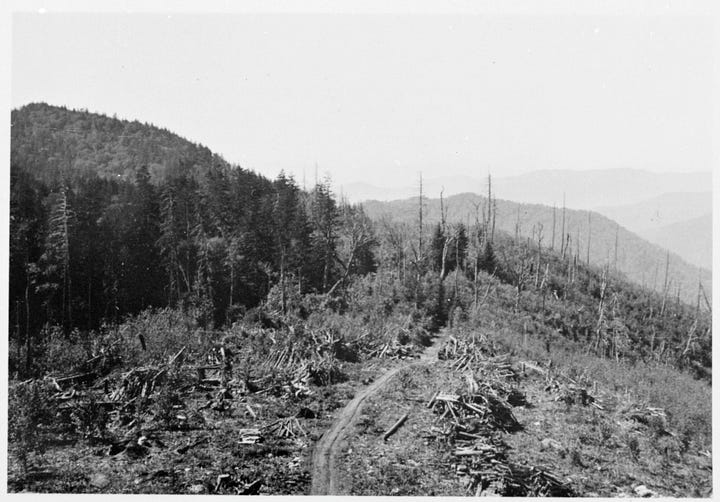
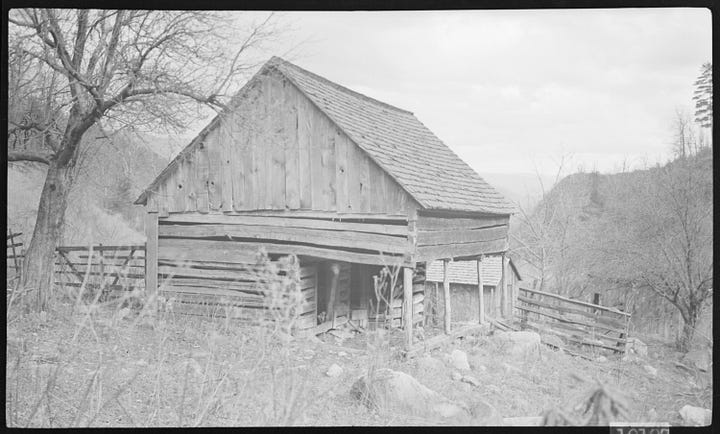
I was so intrigued by the disappearance of American chestnut trees that I dug into the archives and discovered these historical photos.
The photo on the left, taken in 1936, shows dead chestnut trees, cut down, piled up and burned, thus reducing the danger of forest fires in the dead and dry wood, within Great Smoky Mountains National Park. At the right is one example of many barns and houses constructed with chestnut lumber still standing today—this barn is also within Great Smoky Mountains National Park.
Luna Lens
Sharing a photo of my fluffy floofy dog Luna… because there’s plenty of fluff to go around.
Just a few weeks ago, in the midst of March Madness, Luna was truly watching some of the action! (As well as the referees’ decisions!)
Comfort Corner
A great recipe, or a Spotify song. Comfort food or chill tunes. Maybe both.
Chestnuts are not in season right now; otherwise, I would include a chestnut-related recipe! But here’s a similar, nut-inspired recipe that’s delicious, year-round:
Martha Stewart’s Toasted Coconut Granola
Be well—have a wonderful week ahead,
Karen

